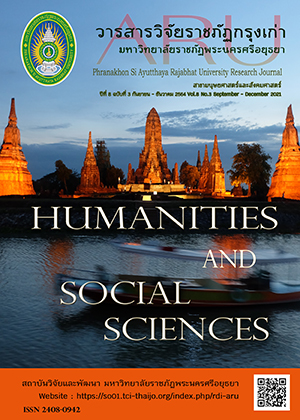Basic Practices as Buddhist of Students from the Faculty of Humanities and Social Sciences
Main Article Content
Abstract
This research aimed to study levels of students’ basic practices as Buddhist from the faculty of Humanities and Social Sciences, Burapha University, and compare levels of students’ basic practices as Buddhist categorized by gender, and academic levels. The research instrument included 5-point scale questionnaire consisting of 28 items. The discrimination was between .21 to .85, while the reliability was at .92. the samples were first, second, third-, and fourth-year students from the faculty of Humanities and Social Sciences Burapha University from the academic year of 2020. The selection was conducted by multi-stage sampling method. With taro Yamane formula, the error was at .05 and representing the samples of 357 people. The data was analyzed by mean, standard deviation, t-test, One-Way ANOVA, and Sheffe’s Method. The research findings are as follows:
- 1. The level of students’ basic practices as Buddhist was at medium level (2.97), holistically. Individually, it found that most of the students practice themselves along with the five precepts on the precept number 3, which is abstention from sexual misconduct, while the second most practiced precept is the precept number 2, which is abstention from theft, another most practiced behavior is that students also pay respects to parents, teachers, and benefactors, and the last most practiced behavior is that the students take part in Dhamma discussions with monks.
2. The comparison of the levels of students’ basic practices as Buddhist when categorized by gender suggested that male and female students showed no different level of basic practices. When categorized by academic level, it found that students with different academic levels showed no different level of basic practices as Buddhist.
Article Details
Journal of TCI is licensed under a Creative Commons Attribution-NonCommercial-NoDerivatives 4.0 International (CC BY-NC-ND 4.0) licence, unless otherwise stated. Please read our Policies page for more information...
References
คณะเทคโนโลยีและการสื่อสาร มหาวิทยาลัยศิลปากร. (2563). หวั่น! เด็กรุ่นใหม่ไม่สนใจธรรมะ เหตุมองว่าน่าเบื่อ. สืบค้นจาก http://www.ictsilpakorn.com/ictmedia/detail.php?news_id=118#.XqQZV2gzZPZ.
คูณ โทขันธ์. (2537). พุทธศาสนากับชีวิตประจำวัน. กรุงเทพมหานคร: สำนักพิมพ์โอเดียนสโตร์.
บุญชม ศรีสะอาด และบุญส่ง นิลแก้ว. (2535). การอ้างอิงประชากรเมื่อใช้เครื่องมือแบบมาตราส่วนประมาณค่ากับกลุ่มตัวอย่าง. วารสารวัดผลการศึกษา มหาวิทยาลัยศรีนครินทรวิโรฒ มหาสารคาม, 3(1), 23-24.
บุญหนา จิมารัง. (2558). รายงานวิจัยเรื่อง ศึกษากระบวนการพัฒนาชาวพุทธต้นแบบและคุณค่าที่มีต่อชุมชน. มหาวิทยาลัยมหาจุฬาลงกรณราชวิทยาลัย วิทยาเขตขอนแก่น, ขอนแก่น.
พระริน อคฺคเตโช. (2556). การศึกษาการเข้าร่วมกิจกรรมทางพระพุทธศาสนาที่มีผลต่อการเปลี่ยนแปลงพฤติกรรมด้านคุณธรรมของนักเรียนชั้นมัธยมศึกษาตอนต้นในโรงเรียนวัดปุรณาวาส เขตทวีวัฒนา กรุงเทพมหานคร.
มหาวิทยาลัยมหาจุฬาลงกรณราชวิทยาลัย, พระนครศรีอยุธยา.
มติชนออนไลน์. (2563). สถานการณ์ปัจจุบันของเด็กและเยาวชนไทย น่าวิตกในอนาคตยิ่งน่าเป็นห่วง. สืบค้นจาก https://www.matichon.co.th/columnists/news_1313057.
สำนักข่าวอิศรา. (2558). ค้นคำตอบ...ทำไมคนไทยห่างไกลวัด. สืบค้นจาก https://www.isranews.org/thaireform-other-news/40254-temple_40254.html.
Cronbach, L.J. (1990). Essential of Psychological testing. (5th ed). New York: Haper Collins.
Yamane. (1970). Statistics: And Introductory Analysis. New York: Harper & Row.

